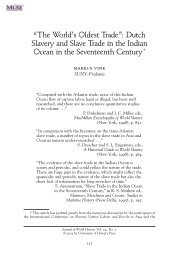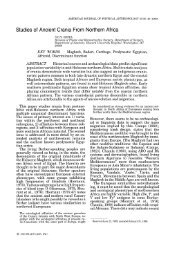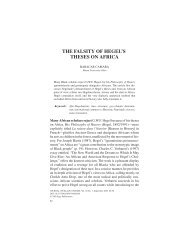Nubian Queens in the Nile Valley and Afro-Asiatic Cultural History
Nubian Queens in the Nile Valley and Afro-Asiatic Cultural History
Nubian Queens in the Nile Valley and Afro-Asiatic Cultural History
You also want an ePaper? Increase the reach of your titles
YUMPU automatically turns print PDFs into web optimized ePapers that Google loves.
N<strong>in</strong>th International Conference for <strong>Nubian</strong> Studies August 20-26, 1998<br />
Museum of F<strong>in</strong>e Arts, Boston U.S.A<br />
Three of <strong>the</strong> Ethiopian queens were central to<br />
significant turn<strong>in</strong>g po<strong>in</strong>ts <strong>in</strong> dynastic history : 1)<br />
Makeda [Queen of Saba, hence "Sheba"] who<br />
founded <strong>the</strong> Menelik dynasty that ruled until <strong>the</strong><br />
overthrow of Haile Selassie <strong>in</strong> 1974; 2) Queen<br />
Ahywa (regal name Sofya), who made Christianity<br />
<strong>the</strong> official religion of <strong>the</strong> Ethiopian k<strong>in</strong>gdom <strong>in</strong><br />
332 A.D.; <strong>and</strong> 3) Gudit, <strong>the</strong> Jewish queen who<br />
founded <strong>the</strong> rival Zagwe dynasty, 933-1253 CE<br />
until <strong>the</strong> Amhara Solomonic l<strong>in</strong>e was restored<br />
(Quir<strong>in</strong> 1992, 12-19). After Gudit, <strong>the</strong>re were no<br />
o<strong>the</strong>r official regnant queens <strong>in</strong> <strong>the</strong> list of<br />
sovereigns. However, <strong>the</strong> Empress of Ethiopia at<br />
<strong>the</strong> time of Abyss<strong>in</strong>ia's defense aga<strong>in</strong>st Italian<br />
colonial ambitions <strong>in</strong> <strong>the</strong> 1930's was Queen<br />
Zaudita, <strong>the</strong> daughter of Menelik II. The Ras Tafari<br />
Haile Selassie was a more remote first cous<strong>in</strong> of <strong>the</strong><br />
emperor <strong>and</strong> <strong>the</strong> son of <strong>the</strong> soldier <strong>and</strong> diplomat,<br />
Ras Makonnen. The power <strong>and</strong> symbolism of <strong>the</strong><br />
Menelik l<strong>in</strong>e that Zaudita represented was<br />
expressed <strong>in</strong> her shared rulership of Ethiopia as<br />
Empress, with Ras Tafari Haile Selassie as Regent<br />
(Rey 1927, 244).<br />
In Mesopotamia <strong>and</strong> its successor states <strong>in</strong><br />
Syria-Palest<strong>in</strong>e, <strong>the</strong>re are also cases of female rulers<br />
remembered <strong>in</strong> world history, such as Queen<br />
Sammu-ramat (Semiramis), Assyrian queen of <strong>the</strong><br />
early 8 th century BCE (Bould<strong>in</strong>g 1992, 196), <strong>and</strong><br />
Zenobia Septima, <strong>the</strong> last of <strong>the</strong> queens <strong>in</strong> <strong>the</strong><br />
Bedou<strong>in</strong> warrior tradition, who was <strong>the</strong> ruler of<br />
Syria from 250-275 CE <strong>and</strong> <strong>in</strong> battle aga<strong>in</strong>st <strong>the</strong><br />
Romans is said to have exhorted her armies to<br />
greater bravery (Ibid, p. 264).<br />
Some Suggested <strong>Cultural</strong>-Historical Patterns:<br />
The follow<strong>in</strong>g cultural-historic patterns are<br />
suggested as possible po<strong>in</strong>ts for fur<strong>the</strong>r study <strong>and</strong><br />
comparative analysis of regnant queens <strong>in</strong> nor<strong>the</strong>ast<br />
Africa, <strong>in</strong>clud<strong>in</strong>g Nubia, <strong>and</strong> southwest Asia<br />
Matril<strong>in</strong>eal succession of regents (descent<br />
traced through a fem<strong>in</strong><strong>in</strong>e l<strong>in</strong>e, mo<strong>the</strong>r to offspr<strong>in</strong>g)<br />
Matril<strong>in</strong>eality <strong>and</strong> regnant queens associated<br />
with non-hegemonic states<br />
3<br />
Queen mo<strong>the</strong>rs <strong>and</strong> o<strong>the</strong>r high rank<strong>in</strong>g women<br />
associated with matril<strong>in</strong>eal succession<br />
c) bro<strong>the</strong>r-sister co-regency a feature of<br />
matril<strong>in</strong>eal succession<br />
2) Fem<strong>in</strong><strong>in</strong>e Orig<strong>in</strong> Myths, Foundresses of<br />
Cities <strong>and</strong> Dynasties<br />
3) Warrior <strong>Queens</strong>; Women at <strong>the</strong> Battlefield;<br />
"Lady of Victory" Tradition<br />
1. Matril<strong>in</strong>eality—descent <strong>and</strong> <strong>in</strong>heritance<br />
traced through women-- has been a controversial<br />
subject <strong>in</strong> anthropology due to <strong>the</strong> fear that<br />
recogniz<strong>in</strong>g descent <strong>in</strong> <strong>the</strong> female l<strong>in</strong>e could lead to<br />
<strong>the</strong> false conclusion that female rule or matriarchy<br />
was <strong>the</strong> prevalent social system. This <strong>in</strong>correct<br />
equat<strong>in</strong>g of matril<strong>in</strong>y with matriarchy, made by<br />
Bachofen <strong>and</strong> his disciples has long been resolved,<br />
but it has left a legacy of suspicion about study of<br />
historical or contemporary matril<strong>in</strong>eal societies<br />
(Fluehr-Lobban 1979).<br />
In Ethiopia <strong>the</strong> historical queens, such as<br />
Makeda, were presented as sole rulers <strong>in</strong> <strong>the</strong> Kebra<br />
Nagast, but it likely that <strong>the</strong>y were co-rulers of <strong>the</strong><br />
state, side by side with <strong>the</strong>ir sons or bro<strong>the</strong>rs<br />
(Kobishchanov 1979, 199). In this case Makeda<br />
would have been co-regent with her son Menelik.<br />
There is a strong correlation between <strong>the</strong><br />
reckon<strong>in</strong>g of matril<strong>in</strong>eal descent <strong>and</strong> <strong>the</strong> presence of<br />
historically-attested regnant queens. This is<br />
confirmed for Kushitic-Meroitic civilization <strong>and</strong> for<br />
<strong>the</strong> <strong>Nubian</strong> Christian k<strong>in</strong>gdoms <strong>in</strong> <strong>the</strong> Sudan until<br />
<strong>the</strong> com<strong>in</strong>g of Islam (Adams 1994; Vant<strong>in</strong>i 1981,<br />
175), <strong>and</strong> may well have cont<strong>in</strong>ued past <strong>the</strong><br />
penetration of Islam <strong>in</strong> certa<strong>in</strong> Sudanic k<strong>in</strong>gdoms.<br />
In Kush-Meroë, all queens <strong>and</strong> k<strong>in</strong>gs had to be born<br />
to a queen, usually <strong>the</strong> ruler's sister; <strong>the</strong>y believed<br />
<strong>the</strong>ir fa<strong>the</strong>r was <strong>the</strong> god Amun; <strong>the</strong>refore each<br />
regent was part div<strong>in</strong>e <strong>and</strong> part human with <strong>the</strong><br />
queen provid<strong>in</strong>g <strong>the</strong> human l<strong>in</strong>k (Haynes 1992, 25).<br />
Flow<strong>in</strong>g from this fact is <strong>the</strong> very high rank<strong>in</strong>g of<br />
<strong>the</strong> Queen Mo<strong>the</strong>r, an attested fact for Kush-Meroë,<br />
which is underscored, for example, <strong>in</strong> <strong>the</strong><br />
importance attached to <strong>the</strong> presence of Taharqa's<br />
mo<strong>the</strong>r at his coronation. One of <strong>the</strong> <strong>in</strong>scriptions of




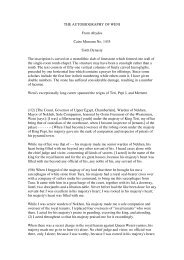
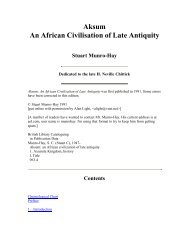
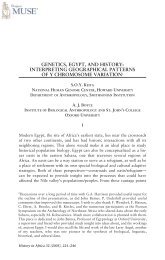

![The Negro trail blazers of California [microform] : a ... - Homestead](https://img.yumpu.com/32436613/1/174x260/the-negro-trail-blazers-of-california-microform-a-homestead.jpg?quality=85)
